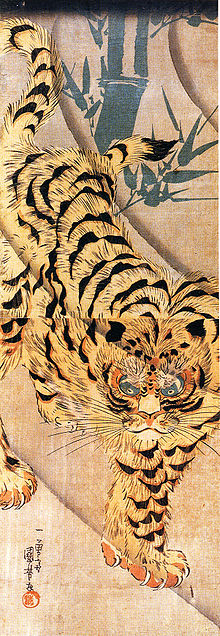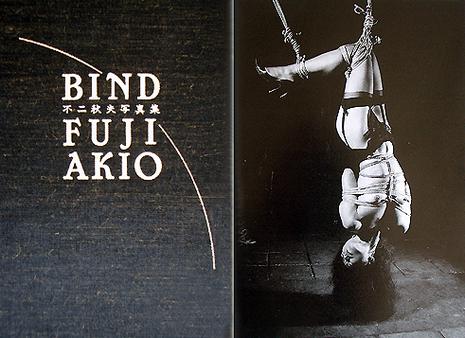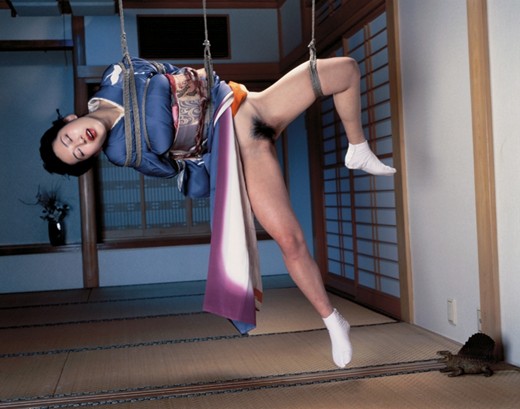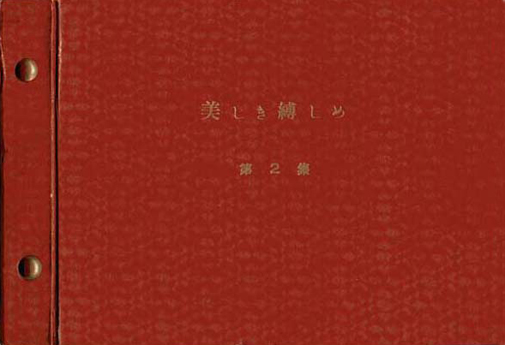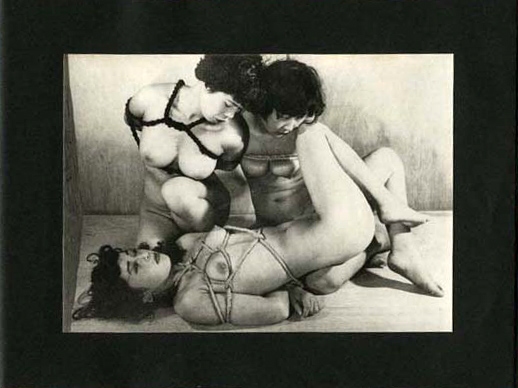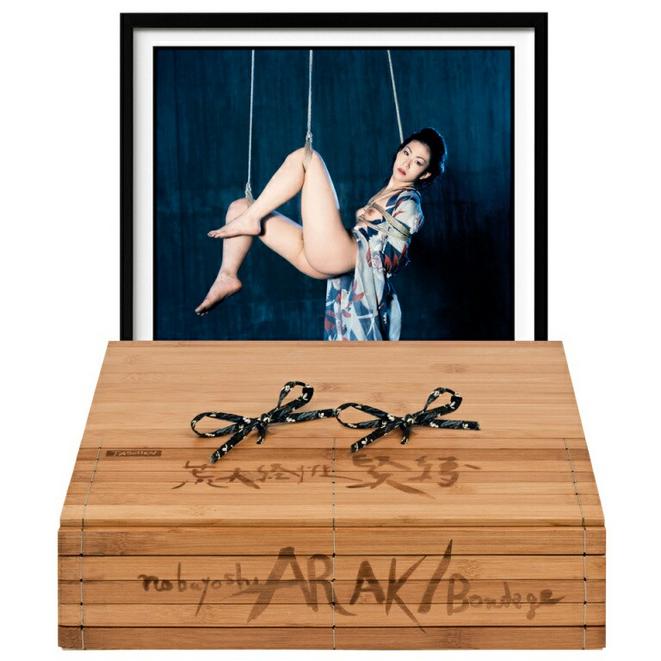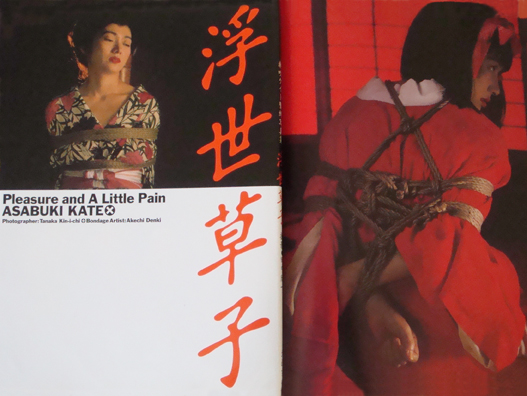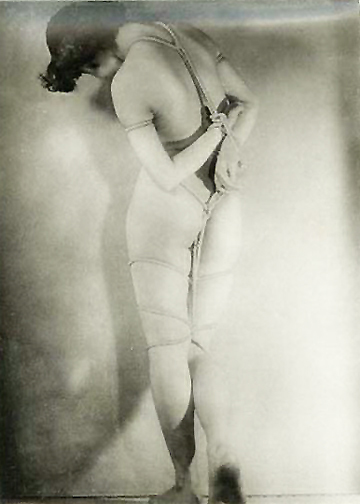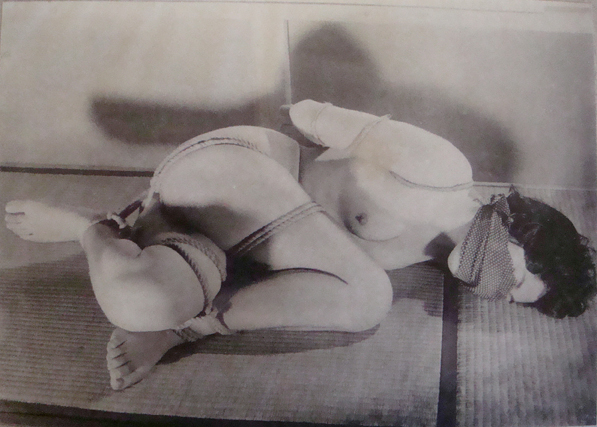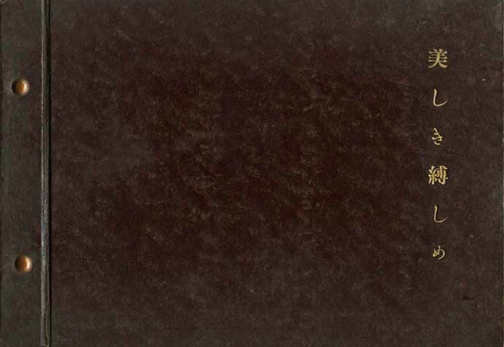Chapter Two
The 10 Greatest Kinbaku Photography Books Ever Published
(imho) - Part 2
by Master "K"
Last time we counted down numbers 10 - 6 of the “Top 10 Kinbaku Photography Books of all Time.” Here are the rest; the best of the best!
5.) Fuji, Akio. Bind. Tokyo: Mole, 1992.
This beautiful little book
was produced in
the style of nishiki-e,
the very small, ultra
"pocket book" style of
volume that was created
for ease of transport in
17th century through
19th century Japan. In
other words, it's another
fine example of good
things coming in small
packages.
It features the wonder-
ful photography of Akio
Fuji and the Kinbaku is
by Nureki Chimuo
working at the height of his powers. What makes this book significant is that it is the catalog for the remarkable showing of Fuji's photographs (which, amusingly, were presented in ultra large format as opposed to the show's catalogue) at the Mole gallery in Tokyo in 1992. As such, it is one of the earliest examples of Kinbaku photography presented as mainstream fine art and for this alone deserves inclusion on our list.
4.) Shigeru, Kayama and Tsujimura, Takashi. Beautifully Bound 2. Osaka: Akebono Shobou, 1953.
The Beauty of Kinbaku
Or everything you always wanted to know about Japanese erotic bondage when you suddenly realized that you didn't speak Japanese
Kinbaku
and Art
Composite photo of the cover of "Bind" and an image from the book.
Cover of the "red" album.
Image from the "red" album. Note the single strand hojojutsu style in several of the ties as well as the more modern, double strand gote on the model at the far right.
Araki's "Bondage/Kinbaku."
Image from Araki's "Bondage/Kinbaku."
Composite photo of the cover of "Pleasure and a Little Pain" and an image from the book.
"The Alcove Ornament."
imo mushi shibari.
Please note: no part of these articles may be reproduced by any means without the express written consent of the author or the publisher, King Cat Ink.
Links to Other Chapters of Kinbaku and Art
This book is called The "red album" by collectors and is one of the more significant books in the history of Kinbaku book publication. It was the follow-up to the first ever serious Kinbaku photography art book that was published in 1953 (which ranks as the # 1 book on this list) and was created in collaboration with the great Minomura Kou. The Kinbaku was by the legendary Tsujimura Takashi, famous for his work on Kitan Club magazine (the grandfather of Japanese SM publications) and for his rigging for films and the photography is by the equally legendary Tsukamoto Tetsuzo, one of the first (and in my opinion the best) Kitan Club lensers. In addition to its early publication date, the significance of the volume historically is in the way that it so clearly shows the influence of hojojutsu (the "capturing and tying" martial art that was the forerunner to modern Kinbaku) and combines that with the then emerging techniques of modern Kinbaku.
This beautiful book is not an easy one to find because it had a limited publication run of only 500 copies. However, with persistence it's still possible, on occasion, to locate it in Japan. It took me years to do so but I finally found a copy and it's now one of the treasures of my collection.
The artist Miyabi Kyodo once described Tsujimura’s shibari as, “First rate.....like water fits into any bowl ......so magically flexible.” Because of this he seems a perfect transitional figure, poised as he is between the feudal world of hojojutsu and the more artistic and safety conscious modernism of erotic kinbaku.
3.) Araki, Nobuyoshi. Bondage (Kinbaku). New York: Taschen America, LLC, 2012.
It might seem unusual to include one of the most recently published Kinbaku photography books in the top five list of historically important publications but in this case I feel it is entirely justified. Not only is the photographer Araki arguably the most famous Japanese photographer working today but his preoccupation with Kinbaku has had the remarkable effect, thanks to his fame and his numerous gallery showings around the world, to say nothing of his over 300 books still in print, of bringing Kinbaku to the general public in a way that has never been possible before.
This publication truly justifies the adjective "monumental" in that it is a compendium of his favorite 600 Kinbaku images (bound in 3 soft cover books) taken over his many years of preoccupation with the subject. Most of these photographs were taken for SM Sniper magazine which was in existence for several decades before it folded in 2008.
The photography is simply superb and the unique manufacture of the book, which is done in the traditional Japanese book making method of binding individual pages together with silk thread and comes housed in a beautifully made, hinged, wooden box, is a testament not only to the Taschen publishing house's desire for quality but also to the fact that Kinbaku really has now moved into a more mainstream position in Western society. This alone merits it a place on our list.
The models are, for the most part, ordinary people who contacted Araki wishing to be photographed and the rope work was done, by and large, by editors from SM Sniper--most notably in recent years by Watanabe Yasuji (more on this interesting gentleman later). The only downside to this book is its remarkably hefty price. Published in a limited series of 1000 copies, the book costs anywhere from $750 to $1000 and even more if you elect to get an original Araki print with the book. A very steep investment to be sure but for anyone in love with Kinbaku this book becomes a must have.
2.) Tanaka, Kinichi and Akechi, Denki. Pleasure and a Little Pain (a photo album). Tokyo: The Japan Mix, 1995.
One of the most beautiful kinbaku photo books ever produced is "Pleasure and a Little Pain" (1995). This quite stunning volume features the actress and model Asabuki Kate with photography by Tanaka Kinichi and shibari/kinbaku by the late Akechi Denki, one of the greatest bakushi ever to have picked up a rope. What separates this effort from all the others is that every element, the lighting, settings, classic costumes, Ms. Asabuki’s expressions and Akechi Denki sensei’s sometimes simple, sometimes complex but always beautiful rope work, combine to enhance one another and produce magical images of mystery, eroticism and dramatic power. If sophisticated and beautiful kinbaku photography interests you, this truly is the gold standard. And fortunately for the collector, this book, though long out of print, does show up for sale from time to time. Last year 5 reasonably priced copies were even offered on US E-bay!
1.) Shigeru, Kayama and Kou, Minomura. Beautifully Bound - The Only Album of Bound Women. Osaka: Akebono Shobou, 1953.
Cover of the "black" album.
The first truly artistic kinbaku book ever published in Japan. "Beautifully Bound – the Only Album of Bound Women” (known by some collectors as the "black album" to distinguish it from the "red album" by Kayama and Tsujimura which appeared a few
months later) was published in 1953 and combined hand printed photos with poetic descriptions affixed to rice paper. It was not only a beautiful volume in itself but began the fashion for “rope books” that continues to the present.
Published on July 1, 1953 in a limited
edition of 500 copies it was sold for
500 Yen, quite expensive for any
Japanese book at that time. Each
volume was a hand made, high
quality album of 36 pages with 16
actual photographs of nude models
in kinbaku, each photograph
carefully glued onto an individual
backing and proceeded by a delicate
page of rice paper containing an
impressionistic description of the
tie and/or the photo.
This lovely book was put together
by Kayama Shigeru, soon to become
a close associate of famed SM
novelist and publisher Dan Oniroku,
one of the most famous BDSM
personages in Japan. The title is
loosely translated as, "Beautifully Bound - The Only Album of Bound Women." The kinbaku is by the master Minomura Kou and the photography is by Tsukamoto Tetsuzo"
Like the "red album" (# 4 on our list), the Kinbaku presented in this book is of great interest because it depicts ties that are halfway between the older hojojutsu schools and more modern shibari/kinbaku. As such, this book is a missing link of sorts for martial arts and shibari researchers. In amongst the older hojojutsu patterns are the modern gote and takate-kote, the historical ebi, various tsuri’s (suspensions) and even more exotic ties such as the imu mushi shibari ("green caterpillar" tie).
"Beautifully Bound" was a tremendous success and spawned the first of many, many sequels (but few as elegant and artistic) that began to be published only a few months later. Because of it's beauty, historical significance and artistry it easily ranks as # 1 on my list of the 10 greatest Kinbaku photography books ever published.
Happy collecting!
Please join me next time as my series on Kinbaku and art continues with an EXCLUSIVE interview with Watanabe, Yasuji, “The Most Famous Bakushi You NEVER Heard Of” and the man responsible for much of the Kinbaku in well known photographer Nobuyoshi Araki’s monumental (and pricey) “Bondage/Kinbaku" which was recently published by Taschen. He is also the rigger responsible for tying American pop diva Lady Ga Ga for her famous "bondage" photo shoot for the Japanese edition of Vogue Pour Hommes!
